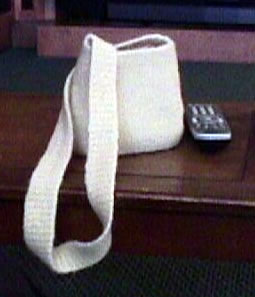Hand Knit Felted Purse From The Knitting Fiend
Visit the whole site or read today's
article at my blog.
|
|
|
The purse is knit from top down in stockinette. I blogged as I knit this purse, and took pictures as I knit the purse. You can read about making the purse here, here, here and finally here. The various discussions show the purse at different stages of knitting.
My purse is knit in Lion Brand Fisherman wool, then felted by throwing it in the washing machine with a load of whites. You can knit yours in any wool that felts; most 100% animal fibers do. I used about 3 ounces to make a 5 1/2" tall, 6" wide, 2" deep purse with 26" straps. If you are using worsted weight yarn, budget about 4 ounces for a purse of this size. If you make it twice as tall or twice as wide, you'll need twice as much yarn as for a purse this size. If you make it twice as tall and twice as wide, you'll need 4 times the yarn!
Felting can be an "iffy" process in the sense that the amount of shrinkage can vary depending on laundering conditions. I'm getting better and better at it. However, I am not a felting guru. I've read lots of advice from guru's, but so far, the only things that seem essential are: 1) Use an animal fiber that felts. 3) Try to have a medium full laundry tub. You want it full enough to actually agitate, but you want the swatch or purse to have room to move. 2) Try to subject the swatch and the purse to very, very similar laundry conditions. Otherwise, you can stop the laundry and keep checking to see if the purse has shrunk enough. But, that's too much trouble for a purse. If you use similar laundry conditions, and enter the data as I suggest, your purse will come out very close the the size you specify when designing.
Lots of machine knitters visit, and are likely to ask me: "Can you knit this by machine?" Sort of; it can be knit very easily on a double bed machine. However, you will need to understand the directions and adapt them to machine knitting. You'll also probably want to substitute something for garter stitch at the top because that's a pain in the neck. I've tried writing directions simultaneously in MK and HK, but it seems to confuse people. So, I'm not trying any more! In any case, is a much more efficient way MK a purse this shape. I already knit one, and I wrote a pattern generator for that one.
Good luck,
Lucia
